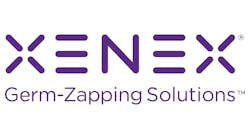Dry Hydrogen Peroxide induced significant positive reduction in environmental contamination on surfaces
Synexis LLC, announced positive new data from a study evaluating the use of Dry Hydrogen Peroxide (DHP) technology in a clinical setting.
The study, published on August 20, 2020, in the peer-reviewed American Journal of Infection Control (AJIC), assessed the efficacy of using DHP technology, in conjunction with standard manual cleaning, in reducing the levels of certain microorganisms (microbial bioburden) in the air and on surfaces within the intensive care unit of a pediatric oncology hospital.
“Immunocompromised patients are potentially susceptible to infection from microorganisms that are not pathogenic to the general population,” said Mario Melgar, M.D., Medical Director for Infection Prevention and Control. “As described in the paper, several studies have demonstrated manual cleaning and disinfection are suboptimal and do not fully eradicate clinically important microorganisms. Our study showed ‘no-touch’ DHP technology was effective in reducing the levels of certain microorganisms on surfaces in an active clinical setting.”
The study was conducted in the Pediatric Intensive Care Unit at Unidad Nacional de Oncología Pediátrica (UNOP), a 65-bed pediatric oncology hospital located in Guatemala City, Guatemala. The hospital is the national referral cancer center for the country and follows all U.S. Centers for Disease Control and Prevention guidelines and recommendations for preventing healthcare-associated infections.
In the study, utilizing installed Synexis DHP devices in occupied spaces as a supplement to standard manual cleaning resulted in statistically significant reductions in microbial bioburden present on surfaces despite the fact that measured levels were relatively low to begin with (p<0.006). The level of reductions in the microbial bioburden was determined on the basis of analyses made of specific bacteria and fungi present in samples taken from occupied rooms with installed, continually operational Synexis devices compared to rooms without a Synexis device (serving as a negative control). All other cleaning and disinfecting protocols remained the same in the control and treated rooms. Study participants reported no adverse events related to exposure to DHP.
“Infectious microorganisms in hospitals represent a serious danger to patients, and unfortunately, manual cleaning does not fully eliminate their presence,” said Eric Schlote, CEO of Synexis. “We are excited that DHP technology is showing positive results in clinical settings.”
Synexis patented technology deploys DHP to actively reduce unwanted microorganisms. When deployed, DHP molecules travel throughout an enclosed space to attack and reduce viruses, bacteria, mold, odors and many insects. Generated from ambient humidity and oxygen present in the environment, DHP can be effectively delivered in occupied spaces at levels well below occupational airborne safety standards established by OSHA, which allows for continuous operation without disturbing normal operations and workflow. As a true gas, DHP is able to impact contaminants in air and on surfaces in hard-to-reach places. When used in conjunction with EPA-approved disinfectants, Synexis DHP can reduce steady-state antimicrobial contamination by up to 99 percent for select organisms.

